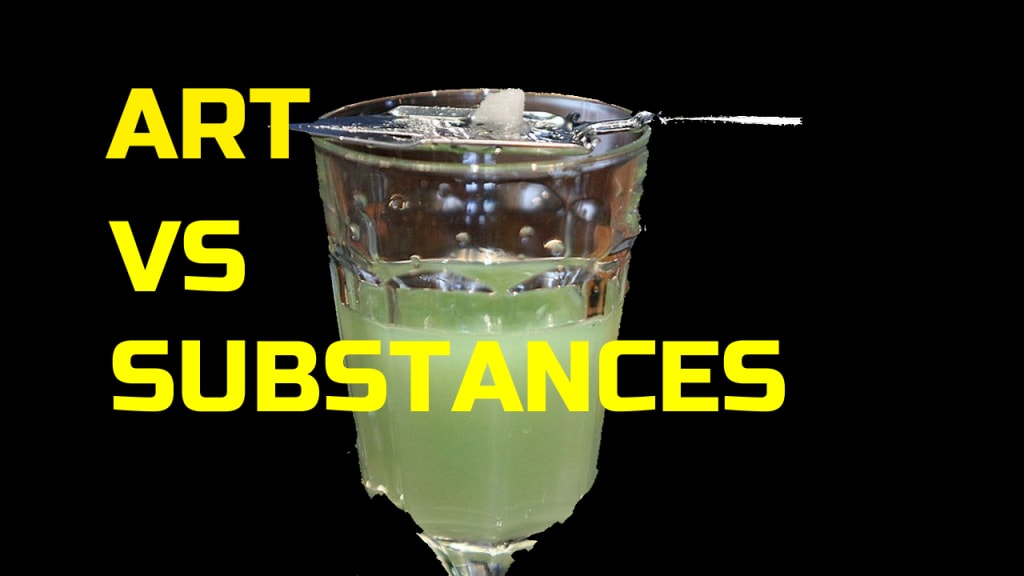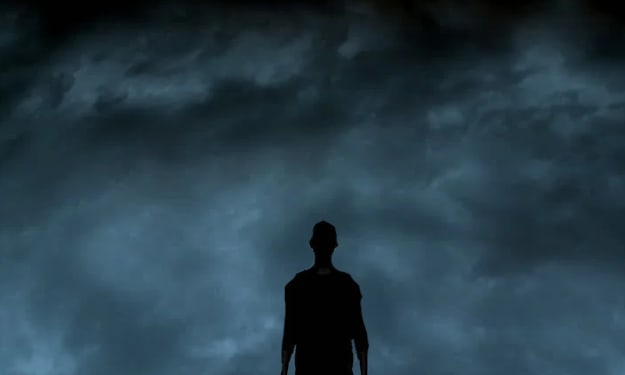Art vs Alcohol (And other drugs)
A study into the relationship between creativity and substance abuse.

Drugs and art have a complicated ebb and flow within our society.
Drugs in the mainstream are, of course, a massive taboo for a variety of reasons. Ranging from legal alcohol to soft drugs like cannabis, and then to the potentially devastating likes of crystal meth and heroin. All of which serve their purpose as an escape from reality to a degree, while vulnerable people often fall into habits of usage, their using is often hidden behind a variety of excuses to validate their consumption.
As a Brit, one who has worked in bars and pubs on and off for almost thirteen years no less, binge drinking is heavily entwined within our social norms. When someone mentions that they don’t drink here, it is often met with a reaction of awe and mystery, as we are just unable to process the idea that some people do not rely on alcohol to be social or to experience fun in the same way we do. Even if someone mentions they are having a month off for religious, health or ethical reasons; there are similar reactions of surprise and something akin to pity, almost as if you are spoiling their night by not allowing yourself to drink to the extent that they are. Many people here find a freedom in it; dismissing the last five days of labour in lieu of two days of escape with your friends.
Another excuse we can give ourselves is for the sake of creation.
Each stimulant has their own properties and effects, and often these range and vary for every different person. There are a variety of reasons for this, current mood, over-arching moods and desires, and they can each effect a single occasion in different ways. For those who seek inspiration through intoxication, some believe that their ideas cannot be matched by sober thought.
While this won’t be an article based on one side or another, and certainly not strewn with my own personal experiences of the two intertwining, we will look at how alcohol and substances have affected artists throughout history, and how we can achieve the same effects without them.
Artists Vs Alcohol
Alcohol has been an important part of society since its dawn. More often than not it proved to be a cleaner and cheaper substitute to water in various civilizations, as opposed to just being used to relax and escape.
It seems only a recent thing to reckon the adverse effects of drink. For most of the 20th Century it was a part of normality, to drink through all hours. Much has changed now, while the problems with alcohol have been as prominent as ever in some regards, our understanding of the problems associated with them has widened. For the most part, anyway.
To briefly and simply summarise the effects of alcohol in our systems, once dissolved by stomach lining, the chemicals are absorbed into the blood stream which quickly make their way to the brain. Initially, this interrupts brain signals, which after prolonged consumption; leads to slurring, confusion and difficulty walking or standing. In the initial moments of drinking, it allows the brain to release Dopamine, which creates a relaxing and pleasurable effect.
The problems lie two-fold, however. Firstly, once we get past the BAC (Blood-Alcohol-Content) of 0.05, is when the depression and disorientation stage occurs. The previous euphoria caused by the release of dopamine quickly turns to melancholy, and more of the blood and tissue start absorbing the alcohol, which leads to confusion and disorientation. Once many get to this point, it is not uncommon to keep drinking to escape this new development, which only causes further problems.
The second is perhaps the most obvious, of course being dependency. People come to rely on the chemical releases as a way to numb their everyday lives and surroundings. It becomes a reward, a meaning to get through the day and everything they despise throughout life for a brief moment of bliss. It is no surprise then, that some of the most creative people in our life-time have struggled with alcohol.
Creativity and intelligence go hand-in-hand, although usually in different ways that what is normally perceived. While conventional intelligence is often viewed by society as dealing with quick formulations and increased memory, creativity is usually attributed to a different outlook than those who view or experience their art. This changed view can be attributed to a number of negative experiences, from wanting to escape into a fantasy world as a child to terrible nightmares. As such, it is no surprise that many people would use alcohol to bury such experiences of trauma. While it often proves healthier in the long-run, creating art can be exhausting and time-consuming, while enjoying a beer has more immediate and easier effects.
There are certain stereo-types that are linked to being a writer, and alcoholism is probably the most notable. I only found out who Ernest Hemingway was a child after hearing that he had stolen a urinal from his local bar, after declaring he had pissed away enough money in it to declare ownership. While Hunter S Thompson was probably best known for his rampant experiences of drug use to some, he still utilised alcohol daily. Stephen King very notably gave up alcohol and cocaine in the late ’80’s, even declaring that he could remember writing none of Cujo.
There are of course hundreds, if not thousands, of other cases, but the problem is just as rampant in all other forms of creativity. Musicians are notable for their ‘Rock n Roll’ lifestyle, which was at first lauded as rebellious and exciting, but now the tragedy of multiple deaths and suicides by substance abuse leaves us all the more sceptical about it.
Changing Mindsets
The most intriguing part of artists who utilise narcotics into their art is often how they try to experience new mental images and experiences that they can correlate and utilise into their craft.
A famous example is of Vincent Van Gogh, who not only struggled with Absinthe, which is of course infamous for formulating hallucinations, mania, psychosis and multiple physical effects, It is also suspected he was prescribed Digitalis, which occasionally has the adverse effect of Xanthopsia, which turns the user’s vision yellow, which may explain the amber hue to many of his later paintings.
The pursuit of drugs is often the pursuit of an altered mind, in the beginning at least. There are times many users can remember a mental image with clarity that they only experienced while ingesting a substance. This can lead to a further pursuit to recreate it, which seldom seem to hit the same level of effectiveness, and thus the user can potentially try experiencing more and more, in a negative feed-back loop desperate to recreate their prior success.
Of course, the contradictions with using narcotics to create are the physical effects associated, including memory-loss, lethargy or restlessness. It is often discussed that over-arching and short-term states of mind directly effect a persons experience. LSD is known for being an intense experience, but this can drastically change base on the willingness and relaxation of the user. It is also disputed that some effects can be based on what the subconscious desires, i.e. how some people can be extremely talkative, while others might want to be quiet and relax.
Hallucinogenic Substances
The craft of creating worlds and imagery with your head is of course visual in it’s intent, but the genesis is not. It is the creator’s duty to create something worth being seen by others, and translate it into the physical world. It makes sense then, that people often try to find new ways to experience new ways to see with the use of hallucinogenic substances.
LSD, DMT and psilocybin (magic mushrooms) stimulate the 2A Serotonin receptor in the brain, at least according to this fancy article here. Many who have tried these substances report not only the visual effects that are most well-known with it, but a disassociation with their selves, and removal from ego and material plane.
Can we recreate the same results without narcotics?
Of course, the negative long-term effects of drug and alcohol use cannot be understated. While some might argue that cannabis has no adverse effects on the human body, its long term effects can be detrimental, most notably how users can come to a point where they find themselves unable to function in modern society without it, with an inability to sleep and a return of depressive episodes they could be potentially hiding from.
Altered states are sought by many as a new way to experience the mundane as well as to create new mental imagery to project to their audience. Sporadic uses can of course provide enlightening, after all the only way to gain new experiences is to actually experience them, and the more experiences we have as a person, the more complete we feel. The problem is due to restraint. There will always be suffering and strife in our short lives, and the best way to escape is with a physical, altering aid. It is up to us as individuals to find the strength for restraint, although that often proves impossible with certain drugs, such as nicotine and heroin. One often has to experience true addiction to find out their limits and overcome them to learn the benefits of restraint, which is never a small task.
Certain reliances are thus born from these experiences. If someone indulges in cannabis and has a night filled with wonderous imagery and inspiration, they will seek to recreate it again and again, but will often find it impossible or at least sporadic to recreate. This then comes to a question of quantity over quality. You may have enhanced and intense moments of brilliance, but the route to find them becomes unreliable.
Out of every artist who has since overcome their addiction and continue to create art in a sober mind, they all seem to prefer their new found clarity. perhaps then, it is not the idea of remaining sober, but experiencing both extremes and finding peace there.
Narcotics are used to drown out anxieties and depressive episodes through the release of dopamine chemicals, but it isn’t the only way these are released. There are dozens of different methods to create these same releases, and some can be found through the act of creation. Your brain often uses this chemical as a reward system when you have done something pleasing. It’s this reward system which works intrinsically, as the act begets the sense of accomplishment.
Clarity can be found through peace, and a clear mind is free to explore every part of your imagination, without worries of unreliability and dilution. Of course I won’t be one to say that purging your system and re-shaking your life into healthy habits will 100% guarantee a change in productivity and inspiration, for I am sure there are millions of those online.
There are a number of ways to perceive the world, some can be learnt, and some are more detrimental than others. True art isn’t always found in an altered mind, as much as it is through one that has found peace within itself and knows what path it wants to take. If you are struggling with an addiction, there is help everywhere, talk to your friends and family, they will give you strength you never knew you needed, and never stop creating.
Do you have any thoughts on the relationship between substances and creativity? Let’s talk about it!
About the Creator
christopher wyer
Hi! I'm a writer from Norwich, UK. Some of The things I love most in life are; Travel, Writing (obviously) films, video games and food, so that's what I write about! If you'd like to see more, please check out Unboundchris.com!
Enjoyed the story? Support the Creator.
Subscribe for free to receive all their stories in your feed. You could also pledge your support or give them a one-off tip, letting them know you appreciate their work.






Comments
There are no comments for this story
Be the first to respond and start the conversation.